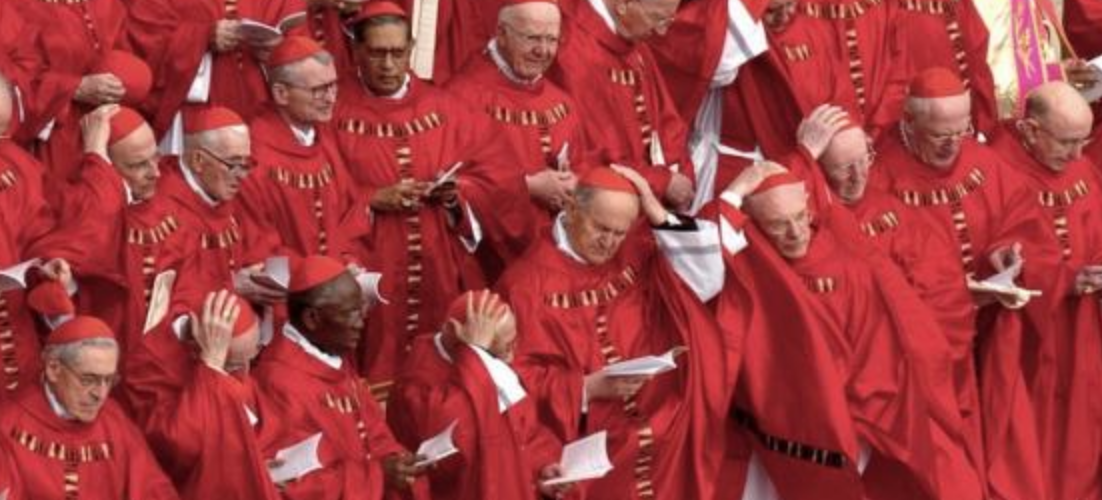Political polarization is nothing new. What about religious polarization? When it comes to matters of faith, specifically the Catholic church and its doctrines, there’s plenty of it these days.
You wouldn’t think there would be much divergence here since adherence to what the church teaches — through the Catechism and centuries of tradition on an array of issues — is the basis for being a member of the Church of Rome. Instead, there is divergence and not just among those sitting in the pews. It’s become all too evident among members of the hierarchy.
To say that the church is at a crossroads isn’t an exaggeration. But fierce arguments between the doctrinal left and right on a host of issues — from Pope Francis’ recent choice of cardinals to how clergy address social issues — are as intense as ever.
But here is the headline right now: Pope Francis has even dared to use a ecclesiastical s-word.”
Yes, that would be schism. That was prompted by a question from The New York Times‘ Jason Horowitz following the pope’s recent Africa trip. In reporting the Sept. 10 story, Horowitz includes this bit of background :
Critics of Francis, must notably Cardinal Raymond Burke, an American who has been repeatedly demoted by Francis, have argued that Francis’ emphasis on inclusiveness, and his loose approach to church law have confused the faithful on a range of doctrinal issues, from divorce to homosexuality. That critique is frequently aired, in sometimes furious language, on conservative American Catholic television channels and websites.
A former Vatican ambassador to the United States, Carlo Maria Viganò, who demanded the pope’s resignation last year, has been hailed as a hero in some of those circles. Bishop Viganò has in part blamed the child sex abuse crisis on Francis’ tolerance for homosexuals in the priesthood, despite the scandal having first festered and exploded under his conservative predecessors, Benedict XVI and John Paul II.
Some of Francis’ closest allies have in recent months publicly said that he is the target of a conspiracy by conservative enemies who are threatened by the more pastoral direction that he has taken the church. One close adviser, Antonio Spadaro, a prominent Jesuit who edits the Vatican-vetted magazine, Civiltà Cattolica, has accused American Catholic ultraconservatives of making an unholy alliance of “hate” with evangelical Christians to help President Trump.
Yes, politics has crept into this divide. But why focus on Catholic media as the source of the discord? It’s true that these divides manifest themselves primarily through news coverage and on social media. These divides are often exacerbated in response to political issues, such as right to die (more on that later). Can one blame “conservative Catholics” for being at odds with the pope over what they see as mixed messages and a watered-down message? The coverage here doesn’t look at schism and what divides the church at the moment, but blames those on the theological right as if this was at its heart a political story involving Fox News and Donald Trump.
There were a few examples of this very phenomena on display in recent weeks. Take, for example, Pope Francis’ announcement earlier this month naming a wave of new cardinals. The coverage concerning Francis’ picks put that journalism polarization on full display.
In Thomas Reese’s column for Religion News Service on the new appointments, he chooses to dwell on what he deems as the positives. Here’s how it opens:
After six years as pope, Francis continues to remake the College of Cardinals in his own image, increasing the likelihood that his successor will continue on the same path as his papacy.
Ten new cardinal electors were announced on Sunday (Sept. 1) and will be “created” at a consistory on Oct. 5. With the appointments, the college will grow to 128 cardinal electors, although within 10 days the number will drop to 124 as four cardinals turn 80, the age at which they can no longer vote in a papal conclave.
After Oct. 15, 53% of the cardinal electors will have been appointed by Francis. Though there are no guarantees how the cardinals will vote, the odds are that his legacy will be felt deeply under the next papacy.
In his selections, Francis has ignored many of the cardinalatial sees, such as Milan, Venice and Philadelphia, from which cardinals have traditionally been selected, because their current archbishops, such as Philadelphia’s Charles Chaput, are not in tune with Francis’ style or policies. Instead he has chosen men who are in sync with him, like Joseph Tobin of Newark, N.J., who was made a cardinal in 2016 while serving as archbishop of Indianapolis.
The column includes lots of statistics of the makeup of the College of Cardinals and how it has shifted geographically under Francis. It could be noted that there was a time when ex-Cardinal Theodore McCarrick carried lots of power in Rome and Washington, D.C.
Compare that coverage to the National Catholic Register’s piece by Edward Pentin, who started off his article like this:
Pope Francis unexpectedly named 13 new cardinals on Sunday, choices that have again revealed his wish for the Church to go out to the peripheries and the developing world.
But they also reveal Churchmen supportive of other issues close to his heart, including open migration policies, concern for the environment and populism, a diplomatic rather than realist stance toward Islam, and sympathies for those supportive of homosexual issues.
“Their origin expresses the missionary vocation of the Church as she continues to proclaim the merciful love of God to every person on Earth,” the Pope said.
The new cardinals, 10 of whom will be eligible to vote in a conclave, will receive their red hats during a cardinal-making consistory on Oct. 5, the vigil of the Oct. 6-27 Amazonian synod. With Francis’ new choices, the number of cardinal-electors will rise to 128, eight more than the number that was recommended by Pope St. Paul VI (Pope St. John Paul II also on occasion exceeded the 120 limit), although the number is to swiftly decline in the coming months.
Pentin, as that newsroom’s Rome correspondent, focuses on fact-drive profiles of the men who will receive their red hats.
Reese, on the other hand, dwells on Francis’ legacy. Reese, writing a column and not a news story, also makes no mention of doctrinal issues linked to homosexuality, an increasing point of debate between pro- and anti-Francis forces in the church following the McCarrick scandal. That is no coincidence here. Reese, a progressive Catholic insider, has clashed with the Vatican in the past, primarily during Benedict XVI’s time as pope.
What Reese’s column (written before the pope addressed schism) fails to capture how important cardinals are in the cities and regions they oversee. More than electing a new pope, these men have to display leadership. In a similar way, a piece in The Catholic Thing (disclosure: I have written some columns therein the past) that ran under the headline, “Assisted Suicide: A Tale of Two Narratives” also highlights what writers choose to highlight as well as lack of local church leadership.
In his column, Richard Doerflinger, who previously worked for the U.S. Conference of Catholic Bishops’ Secretariat of Pro-Life Activities and is a Fellow at the University of Notre Dame’s de Nicola Center for Ethics and Culture, looked at the coverage — specifically by The Associated Press — regarding the assisted suicide of a Seattle man named Robert Fuller. (Also, see this recent update on the case by Julia Duin here at GetReligion.)
The Associated Press feature details how a priest blessed Fuller, raising questions on what the church knew and didn’t know about the man’s intentions.
This is what Doerflinger has to say:
What lessons can we learn from this?
First, some parishioners (notably his longtime friends in the choir) knew of Fuller’s plans and accepted them, even attending that final party. This is a grave wrong and a scandal. But some Catholics have trouble believing that these priests were initially unaware of Fuller’s intentions. As a parishioner in the Seattle archdiocese, I disagree.
The priest shortage here is severe. My own pastor has care of four parishes and a mission, and for part of this year didn’t have a parochial vicar. He does an amazing job in difficult circumstances, helped by retired and visiting priests and lay administrators.
Fr. Dupont, a full-time graduate student at the University of Washington, was visiting St. Therese’s solely to say Mass, as he has done before (there and at another parish, despite his academic workload). The pastor, Fr. Maurice, has sole care of two parishes; that morning he was saying Mass at his other church, where he resides.
If you are upset that our priests barely have time to provide the sacraments, let alone get to know the inner lives of their parishioners, I agree. Please join me in praying for more priests.
Second, could anyone have blocked Fuller’s plans? It seems doubtful. He was “half in love with easeful death” for most of his life. AP reports that when he was eight years old in New Hampshire, his beloved grandmother drowned herself in the Merrimack River. From this he says he learned: “If life gets painful, you go to the Merrimack River.”
These are two very good points, but it doesn’t end there. Doerflinger also noted that the AP “violated all guidelines endorsed by the World Health Organization and suicide prevention organizations to keep news reports on suicide from leading other depressed and vulnerable people to take their lives.”
Consider this: The headline on the AP story was “In the face of death, the party of a lifetime.” The AP article also fails to quote the Catechism of the Catholic Church on this issue in moral theology.
This is how Doerflinger concludes his piece:
The Catechism of the Catholic Church (Paras. 2280-83) makes three things clear: Suicide is gravely evil; personal responsibility for it can be greatly diminished by factors such as anguish, fear of suffering, or psychological disturbance; and the Church does not despair of the salvation of those who take their lives but prays for them, knowing that God may lead people to repentance at any time in ways known to Him alone.
The actions of clergy in this case, therefore, seem consistent with this particular application of St. Augustine’s maxim to hate the sin but love the sinner (or better, to hate the sin because we love the sinner). That maxim, mocked by secularists, is difficult to live by – especially on matters of sexuality or life itself. Some Catholics are tempted to err by hating sin and sinner together, others by thinking they have to love and accept both. Yet it seems to me, that maintaining those distinctions – and keeping that balance – is central to our Catholic faith.
In conclusion, let’s look at another column on a different issue. This Patheos piece by Father Dwight Longenecker, a former mainstream journalist, ran with this headline: “Catholic bishops and limousine liberals.” It included plenty of theology and church history — something mainstream press articles often lack.
In it, he takes aim at disgraced Bishop Michael Bransfield of West Virginia. Bransfield spent nearly $1 million on private jets and over $660,000 on airfare and hotels during his 13 years as bishop. Longendecker starts here:
A Catholic priest friend of mine commented recently, “We’re in a sixteenth century situation.”
You might remember that the sixteenth century was one of enormous upheaval, turmoil and crisis. Martin Luther was on a roll, Henry VIII was on the rampage, the political situation was tense and meanwhile the Renaissance popes fiddled while Rome burned…this was not quite literally true. The Medici Pope Clement VII didn’t fiddle while Rome was sacked and burned, but he did flee for his life to the Castel Sant Angelo. Then, when the tide had turned, went back to the same old same old.
The recent investigation into McCarrick protege, Bishop Bransfield of West Virginia reeks of the same corruption.
Yes, the current polarization within the church is real and, in this case, there is one of McCarrick’s many proteges at the center of it all.
This divide over doctrine and who’s to blame for the church’s ills will persist. Again, this is a battle that will be played out in a media marketplace that features many different kinds of coverage — with mainstream media competing with various kinds of religious news outlets. That’s a topic I wrote about a year ago at this time.
In many ways, there already is a digital Catholic schism. Whether Francis can keep the Church of Rome united may really be what his legacy will be all about.










